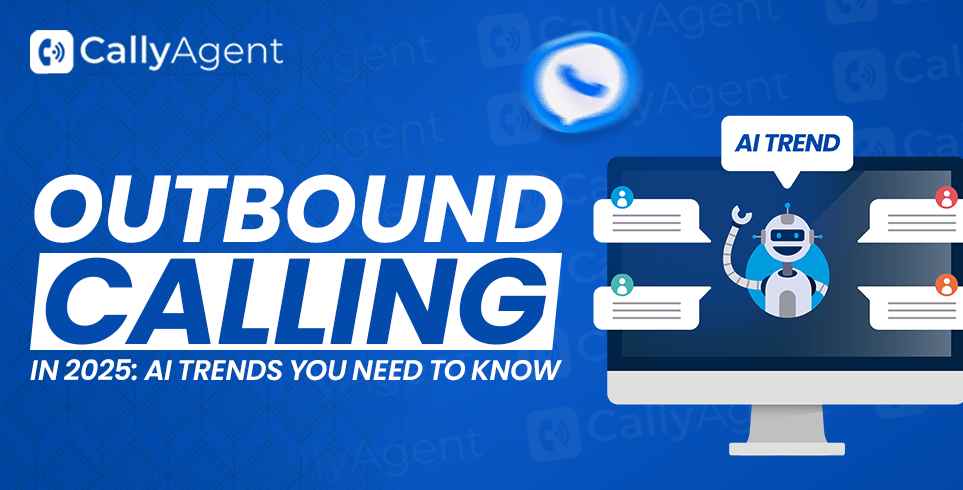
Outbound Calling in 2025: AI Trends You Need to Know
It’s 2025, and outbound calling isn’t what it used to be.
The old way—hiring armies of SDRs to manually dial down spreadsheets—is no longer sustainable. Reps are overwhelmed. Prospects are guarded. And decision-makers don’t have time for cold pitches that miss the mark.
But here’s the good news: outbound calling isn’t dead.
It’s just evolving.
And the businesses that adapt are the ones leveraging voice AI, automated workflows, and data-driven personalization to reach leads at scale—without losing the human touch.
Let’s break down the most important AI trends shaping outbound calling in 2025, and how forward-thinking businesses are using them to start better conversations and close more deals.
1. AI Agents Are Now a Core Part of Sales Teams
In the past, outbound calls meant human reps making one call at a time, following a script, and hoping for the best.
Now?
AI calling agents like Cally Agent are taking over the front line.
They don’t just sound human—they act human. These voice agents are trained on thousands of sales calls, objection-handling scenarios, and high-performing sales patterns. They’re able to:
- Greet leads naturally
- Ask qualifying questions
- Handle common objections with confidence
- Book appointments on the spot
And they do it all without tiring out or needing lunch breaks.
This isn’t automation for the sake of efficiency. It’s sales enablement at scale—and it’s helping sales teams focus their energy where it matters: closing deals, not chasing cold leads.
2. Natural Voice Technology Has Gone Mainstream
One of the biggest changes this year? The massive improvement in voice AI realism.
Forget robotic tones and awkward pauses. In 2025, AI voices feel real. Thanks to integrations with tools like ElevenLabs and Synthflow, today’s outbound calls sound like genuine, two-way conversations.
This shift has changed how prospects respond.
When the call feels human, people engage. They don’t hang up right away. They’re more open. More curious.
That extra five seconds of attention? It’s often the difference between getting ghosted and getting a meeting.
3. Objection Handling Is No Longer Left to Chance
Reps hate objections. Most aren’t trained to handle them well. And when they’re tired, distracted, or feeling off—it shows.
AI voice agents don’t have that problem.
They’re built to handle objections in real time, with tested replies that are clear, calm, and respectful. Whether it’s:
- “Not the right time”
- “We already have a vendor”
- “Send me an email”
The response doesn’t come from a generic script. It’s based on intent recognition and conversational flow, not just keywords.
This gives the conversation a more natural rhythm. Instead of sounding like a pitch, it feels like a conversation—one that builds trust.
4. Multi-Channel Integration Is the New Standard
In 2025, outbound calling doesn’t happen in isolation. Your prospects don’t just get a cold call—they see a message on LinkedIn, a personalized email, maybe even a remarketing ad.
And your AI calling agent? It’s part of that ecosystem.
With CRMs, outreach tools, and scheduling platforms all connected, the AI agent knows:
- When the lead last engaged
- What content they’ve seen
- Which product they were interested in
This context means the call doesn’t start from zero. It starts with relevance.
It also helps teams manage follow-ups more strategically, ensuring no warm lead gets left behind.
5. Data-Driven Feedback Loops Make Every Call Smarter
Manual sales coaching is valuable—but it’s slow. You record calls, review them weekly, and hope reps improve.
With AI-led calling, performance feedback is instant.
Each objection, pause, hesitation, or keyword gets logged, analyzed, and used to refine future calls. If a certain pitch isn’t landing, it gets flagged. If a new trend appears—say, more leads asking about pricing upfront—it gets addressed in real time.
It’s like having a full sales coaching team monitoring every call—only faster, more accurate, and working 24/7.
6. Human + AI = High-Performance Sales Teams
AI calling doesn’t replace your team—it empowers them.
Picture this: Your AI agent makes 2,000 calls a week. From those, it books 50 qualified appointments. No wasted time. No burnout.
Your human reps?
They step in to close deals, build relationships, and guide leads through the buying process.
In this hybrid setup, everyone operates at their highest level. SDRs aren’t wasting hours on voicemails or gatekeepers. And your AI agent is doing what it does best: consistent, smart, proactive outreach.
7. Compliance and Transparency Are Built In
With stricter data laws and increasing call regulation, outbound calling in 2025 needs to be compliant by design.
AI agents like Cally Agent are built with compliance in mind, ensuring calls are recorded, disclosures are delivered, and consent is respected.
This doesn’t just protect your business—it builds trust. Your leads know who’s calling, why they’re being contacted, and how to opt out if they choose. That kind of transparency pays off in long-term brand credibility.
Final Word: Outbound Isn’t Dead—It’s Getting Smarter
The companies winning in 2025 aren’t sending more emails or hiring more SDRs.
They’re using smarter tools to reach the right people at the right time—with the right message.
Outbound calling still works. But only if it’s relevant, respectful, and real.
AI isn’t the enemy of personalization. When used right, it’s the fastest way to personalize at scale—without the mistakes, fatigue, or inconsistency of a purely human team.
And as prospects get harder to reach and sales cycles get longer, every competitive edge counts.
So if your sales strategy still looks like it did in 2020… it might be time for a serious upgrade.
